The chemistry of taste and flavour
Eating and drinking is a sensory experience – visual, tactile, olfactory and gustatory. The last two, smell and taste, are the most important, and come into play to detect the chemical compounds responsible for the flavour of the food or drink. Smell makes the most important contribution to flavour detection and the combination of aroma compounds in any given food or drink can lead to a potentially limitless number of different flavours. In contrast, there are only five basic taste sensations: sweet, salty, sour, bitter and savoury (umami). Tasting and smelling are two completely separate physiological processes. Taste is perceived in specialized taste buds on the tongue and other parts of the mouth, while smells are captured by specialized receptor cells located in the top of the nasal canal. Only volatile compounds with a small molecular weight (less than about 400) that are able to diffuse into the air can be detected as aromas. It is therefore surprising that 80% of what we call taste is actually produced by the aroma of food, which the brain associates with that food. The process of smelling is different from tasting, because smelling occurs during the process of inhalation, while flavour perception occurs during exhalation. The aroma of a food item outside of the mouth therefore differs from the aroma when it has already been taken into the mouth. The art of cooking is the creation of unique combinations of tastes and flavours, integrating and balancing the inherent tastes and flavours of the food items with the addition of seasonings, and aroma-rich and/or tasty herbs and spices.
Many culinary herbs contain essential oil as their main flavour compounds. Examples of plant families with a high frequency of occurrence of volatile oils are the celery family (Apiaceae), mint family (Lamiaceae) and citrus family (Rutaceae). The oils are typically formed in pellucid glands within the leaves (visible as translucent dots when the leaf is held against the light) or in glandular hairs on the leaf surface. In the case of the Apiaceae, the oil is formed in resin ducts that occur in the leaves and fruits. Specialized oil cells (called vittae) are a special feature of the small dry fruits in this family. These fruits (often wrongly referred to as “seeds”) are called schizocarps because they usually separate into two halves, the mericarps, at maturity. Well-known examples include anise, caraway, celery, coriander, cumin, dill and fennel. In Citrus species (lemons and limes), oils are not only formed in the leaves (petitgrain oils) but also in the glandular coloured part of the fruit rind (peel oils). Fresh peels are an essential component of many dishes and are used in the form of zest – the coloured part of the peel (flavedo) is grated, leaving behind the spongy white layer (albido). The dried peel of tangerine is an important spice in southern Chinese and Cape cooking (used with sweet potato).
Essential oils are often complex mixtures of up to 60 or more individual chemical compounds and it may be hard to predict which component (or combination of compounds) is responsible for the characteristic aroma and flavour of the herb. In some cases it is easy: limonene gives the typical lemon flavour, (−)-carvone spearmint flavour, anethole anise flavour, menthol peppermint flavour and camphor the typical camphor smell.
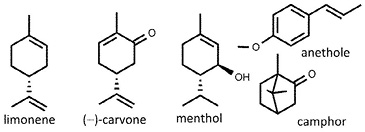
Of interest are volatile sulphur-containing compounds such as allicin, found in garlic, dimethyl sulphide in the aroma of both white and black truffles (although the typical mushroom flavour is mainly due to 1-octen-3-ol, also known as mushroom alcohol). Another group of flavour compounds is represented by allyl isothiocyanate and other volatile mustard oils, produced by plants such as mustard, horseradish and wasabi (family Brassicaceae). Headspace analysis and other chromatographic techniques are continuously expanding our understanding of the aroma impact of individual essential oil compounds. In some cases the aroma impact is produced by a minor constituent that occurs only in trace amounts but has a very low threshold of detection. In other cases the unique aroma may be the result of an additive or even synergistic effect of several volatile compounds.
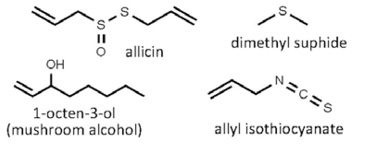
When heat is applied to some foods, a non-enzymatic browning occurs, and hundreds of new and pleasant flavour compounds are created. Two different and as yet poorly understood processes may be involved, depending on the level of heating and the substances that are heated. The one is caramelization, also called toasting, a partial burning process (pyrolysis) through which sugar turns brown and releases volatile compounds with a typical caramel flavour. Many of us make use of this process every day when we make toast for breakfast. The sugars in the bread are caramelized, resulting in the familiar brown, crisp and tasty outer layer. The other process is roasting (called the Maillard reaction), a chemical reaction between amino acids and reducing sugars caused by heat. The most familiar examples are the roasting of coffee beans and the tempering (brief roasting) of herbs and spices during the initial phases of cooking to release the flavours. Complex mixtures of aroma and flavour compounds are formed when the nucleophilic amino groups of amino acids react with the carbonyl groups of the sugars. The type of compounds that form depends on the type of amino acids that are present. The Maillard reaction (often in combination with caramelization) is responsible for the flavour and taste of toasted bread, French fries, malted barley, roasted coffee, roasted meat and maple syrup. One of the common flavour compounds created by the Maillard reaction when baked goods such as biscuits, bagels and tortillas turn brown or when popcorn is heated is 6-acetyl-2,3,4,5-tetrahydropyridine. A similar flavour is found in 2-acetylpyrroline, a substance that occurs naturally in fragrant rice and in the wilted leaves of the fragrant pandan (Pandanus amaryllifolius). The minimum level of detection of both these aroma compounds is less than 0.06 nanograms per litre. (An average human cell weights 1 ng, a grain of maize pollen 250 ng). Enzymatic browning of food is generally unwanted (e.g. the browning of bananas or the surface of cut apples) but it plays a crucial role in the colour and flavour of tea and dried fruits such as raisins and figs.

Another important and complicated method commonly used to create new foods and food flavours is through controlled fermentation. During the process, sugars are converted to alcohol or organic acids and proteins are broken down to amino acids through the action of microorganisms (yeasts and bacteria). It is used in a very wide range of foods and is often responsible for the umami taste (e.g. in fish and soy sauce). Examples include products based on fermented beans (miso, nato, soy sauce, soy paste, tofu), grains (beer, kvass, bread, injera, rice wine, whisky, vodka), fruits (wine, vinegar, cider, brandy), vegetables (sauerkraut, kimchi, pickles), honey (mead, tej), tea (kombucha), milk (yogurt, quark, cheese), fish (garum, fish sauce, shrimp paste) and meat (chorizo, jamón ibérico, pepperoni, salami). Vegetable proteins may also be broken down to amino acids and associated umami flavour compounds through direct acid hydrolysis, resulting in so-called acid-hydrolysed vegetable protein or HVP. The dark brown liquid that is formed contains glutamic acid (the well-known flavour enhancer) and other natural amino acids and is nowadays commonly used in the manufacture of commercial soy sauce. A similar result is achieved by processing yeast proteins, resulting in dark brown savoury products well known under brand names such as Marmite and Vegemite (see notes under umami, the fifth taste).
The senses of touch (tactile or somatosensory detection) and vision are also relevant. Pungency, the “hot” or “spicy” taste of chilli peppers, black pepper, ginger and horseradish is traditionally viewed as a sixth taste in India and China but it is technically not a taste because the burning sensation does not arise from taste buds but from a direct stimulation of somatosensory nerve fibres in the mouth (those responsible for the detection of pain and temperature). There are several different somatosensory effects that contribute to the overall impression of a food item. A pungent and burning sensation is caused by capsaicin in chilli pepper, allyl isothiocyanate in mustard oils and piperine in black pepper. An imaginary cool sensation is typical of menthol in peppermint and camphor in camphor oil, while a tingling or “tingling numbness” sensation is created by substances such as spilanthol (in spilanthes, Spilanthes acmella) and hydroxy-α-sanshool in Sichuan pepper (Zanthoxylum piperitum). An astringent or “puckering” sensation is commonly caused by tannin-rich foods and wine. A “metallic” taste (usually unacceptable) is caused by certain foods. The Scoville scale is a measurement of the pungency of chilli peppers, created by Wilbur Scoville in 1912. The number of times a measured amount of pepper extract has to be diluted to make the capsaicin undetectable gives the Scoville heat units (SHU). Pure capsaicin, for example, has a Scoville rating of 16 000 000, while the rating for extremely hot chilli peppers exceeds 200 000. The method is imprecise and has largely been replaced by direct measurement of the level of pungent chemical(s) using high-performance liquid chromatography.
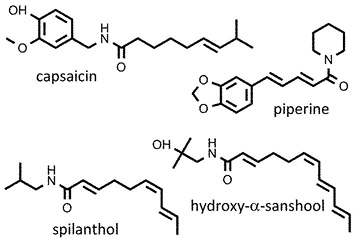
Two cultural factors may result in the same taste experience being described as pleasant or unpleasant. Firstly, the temperature at which the food or drink is served must match the expectation or custom. Secondly, the appearance and colour of the food items must be attractive. Red or orange-coloured drinks, for example, tend to be perceived as sweeter than green-coloured drinks even if they are otherwise identical. The principle is also used in charcuterie (a reddish purple or pinkish colour is desirable in processed meat) and in dairy products (where a yellow colour is called for in butter and cheese).
The ability to taste, known as gustatory perception or gustation, has an important survival value for humans and animals. A sweet taste indicates energy-rich food; an umami taste indicates the presence of important amino acids (the building blocks of proteins); a salty taste helps to regulate the electrolyte balance in the body; a sour taste may give a signal that the food is fermented and perhaps no longer safe; a bitter taste gives a warning of the presence of natural toxins – the majority of poisonous substances are intensely bitter. There are genetic differences in the ability to taste. Persons with an exceptionally sensitive sense of taste are called supertasters. Children are much better at tasting than adults, because about half of our taste buds are lost before the age of twenty. Some foods or drinks may have an aftertaste that can be different to that of the food or drink itself. An acquired taste is a liking for a food or drink that develops over time after an initial phase of dislike, caused by some unfamiliar aspect such as a strange odour, taste or appearance.
Humans and animals can taste food because of the presence of a complicated sensory system comprising thousands of taste buds in the mouth and throat, with nerves connecting them to the brain where the chemical signals coming from the taste buds (each with 50 to 100 or more taste cells) are interpreted. The taste buds are the main sensory organs and are highly concentrated on the top of the tongue, where they are located in thousands of small papillae, visible to the naked eye. Each papilla contains hundreds of taste buds. Taste buds are also present on the roof, sides and back of the mouth and in the throat. The idea that certain parts of the tongue have different taste buds for detecting sweet, sour, bitter or sour taste is a common misconception. The density of taste buds varies in different parts of the mouth and tongue but the taste buds themselves are all the same.
The chemical compounds responsible for taste dissolve in saliva and can then enter the taste buds through pores. Once inside the pore, they interact with either ion channels or with proteins on the surfaces of taste receptors. This interaction triggers chemical signals which are transmitted to the brain through the central nervous system. Sweet-tasting molecules trigger a response by binding to T1R2 and T1R3 proteins in the taste cells; bitter molecules bind to T2R receptors, umami molecules bind to T1R1 and T1R3 receptors and both sour and salt molecules enter the taste cells and flow through ion channels. The various receptors in the taste cells and the flow rate of the active compounds allow the brain to distinguish between different tastes and also the magnitude of each taste.

Sweetness
Sweet tastes are triggered by sugars and a few other natural and artificial compounds. Nowadays we use pure sugars such as sucrose (table sugar) but the original source of sweetness was foods rich in carbohydrates such as honey, sweet-tasting fruits and sucrose-rich phloem sap from sugar cane and palm stems. Sugar and honey are important sources of energy. Sugars differ in their sweetness, usually measured relative to the sweetness of sucrose, which is taken as 1. Glucose is less sweet than sucrose (sweetness value of ca. 0.75) while fructose is sweeter (sweetness value of ca. 1.5). Natural sources of sugar such as molasses and palm sugar are not only used for the sugar they contain but also for a diversity of natural flavour compounds that are often essential for the success of certain dishes. Sucrose, glucose, fructose and lactose (found in milk) are amongst the most important natural sugars in the human diet, while starch is the most important carbohydrate. It forms the bulk of staple foods such as wheat, maize (corn), rice, potatoes and cassava and the processed foods derived from them, including bread, pasta, noodles, porridge, pancakes and tortillas.

Starch is a polysaccharide consisting of a large number of glucose molecules arranged into amylose and amylopectin units. Amylopectin usually represents about 80% of the total starch, but some cultivars of maize and rice (known as waxy maize and glutinous rice) have only amylopectin and no amylose. The enzymes that hydrolyze starch (known as amylases) are present in human saliva and are also produced by the pancreas. Amylase from the surface of grains such as barley breaks starch down into maltose units during the process of malting (mashing). Cooking is necessary to improve the digestibility of starch, so that the use of fire was a prerequisite for the switch in the human diet from low to high starch. Human populations with starch-rich diets tend to have more amylase genes. Starch is commercially hydrolyzed by acids and/or enzymes into fragments known as dextrins. Examples are maltodextrin, an almost tasteless filler and thickener, and glucose syrup (known as corn syrup in the USA), used as sweetener and thickener, in processed food. A complete breakdown gives dextrose (commercial glucose). Dextrose solutions can be enzymatically modified (using isomerase) so that many of the glucose molecules are converted to fructose, thus producing so-called “high fructose corn syrup”, which is the main sweetener used in the USA for processed foods and beverages.
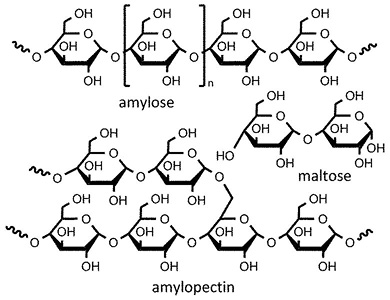
The long-term intake of too many calories and lack of exercise lead to weight gain and poor health but eating too few calories can be equally harmful. The recommended daily intake for an adult is 2 000 calories and the recommended daily sugar intake is 90 grams. Each gram of sugar adds four calories to the diet (fat adds nine, alcohol seven) but it should be taken into account that fruits, vegetables, milk products and soft drinks all add to the daily sugar intake.
Natural and artificial non-sugar sweet substitutes such as xylitol, saccharin and aspartame have become popular to control weight and health, especially for diabetics. However, the excessive use of artificial sweeteners may disturb the body’s natural ability to regulate carbohydrate intake and thus lead to weight gain rather than weight loss.

Some plant glycosides are much sweeter than sugar, such as glycyrrhizin from liquorice root (30 times sweeter than sucrose) (see Glycyrrhiza glabra) and stevioside from stevia leaves (250 times sweeter than sucrose) (see Stevia rebaudiana). Thaumatin, a sweet protein from the West African katemfe fruit (Thaumatococcus daniellii) is 2 000 times sweeter than sucrose. The sweetest known chemical compound is a synthetic substance called lugduname, with a sweetness value up to 300 000. It has not yet been approved for human use. Some natural compounds are able to inhibit sweet taste perception, including gymnemic acid from the leaves of gymnema or gurmari vine (Gymnema sylvestre) and ziziphin from the leaves of the Chinese jujube (Ziziphus jujube). Lactisole is an artificial sweetness inhibitor used in some sweet jellies and fruit preserves to suppress the sweetness and bring out the fruit flavours. In contrast, miraculin, a tasteless glycoprotein from the miracle fruit (Synsepalum dulciferum) and curculin, a sweet-tasting protein from the lumbah plant (Curculigo latifolia) modify taste buds so that sour foods are perceived as sweet. The effect lasts up to one hour.
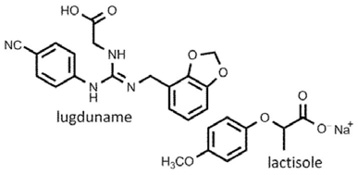
Sugar is a natural preservative, widely used in jams, jellies, syrups and sauces. White or brown sugar also has an important role in cooking because it acts like a seasoning to enhance and balance flavours. A pinch of sugar added to carrots, peas and sweet corn improves the taste. Sugar is often added to tomato dishes, soups and stews to reduce the acidity and improve the flavour. Chinese chefs use sugar to produce the typical sweet and sour tastes associated with meat dishes. Sugar is used in baking and candy-making, not only to ensure the desired texture but to contribute to taste and colour. When heated, sugar caramelizes – an effect seen (and tasted!) when toast turns brown. Sweet (and sour) tastes are often added to dishes in the form of dried fruits such as dates, figs, prunes and apricots.

Sourness
Sour taste or acidity is triggered by natural acids such as acetic acid, citric acid and tartaric acid. The sourness of a food or substance is measured by comparison to dilute hydrochloric acid, which has a sourness index of 1. Citric acid, present in lemons and limes, for example, has a sourness index of 0.46. The most common food sources containing acids are fruit such as apricots, lemons, limes, oranges, grapes, tamarind, sour figs and kokum. The choice of acid can influence the taste of food because they are slightly different in taste. Vinegar is the most widely used sour condiment. It contains acetic acid, which gives it a sour taste and distinctive smell. Ascorbic acid, better known as vitamin C, is a useful food preservative present in lemons and other fruits and has a crisp and slightly sour taste. Citric acid is responsible for the acid taste of citrus fruits, while oxalic acid is found in rhubarb and sorrel. Lactic acid is present in fermented milk products (e.g. sour cream) and gives these products a distinctive and pleasant sour taste. Malic acid gives apples and apple cider its delicious sour taste, while tartaric acid does the same in grapes and wine (and phosphoric acid in carbonated soft drinks).
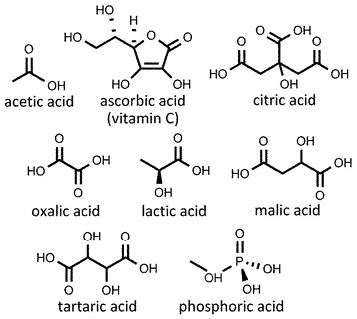
The balance between sweetness and acidity is an important aspect of cooking and the contrast is exploited by skilled chefs to create unforgettable dishes. The desired effect can be achieved by combining sour and sweet food items on the same plate or by incorporating them into a single dish, such as sugar and vinegar with sweet and sour-tasting fruits, as used in Chinese (Cantonese) sweet and sour pork. This dish demonstrates the Chinese philosophical principle of yin and yang – opposites that complement each other. Another example is the popular “sour candy”, sweets in which sugar is combined with citric acid.
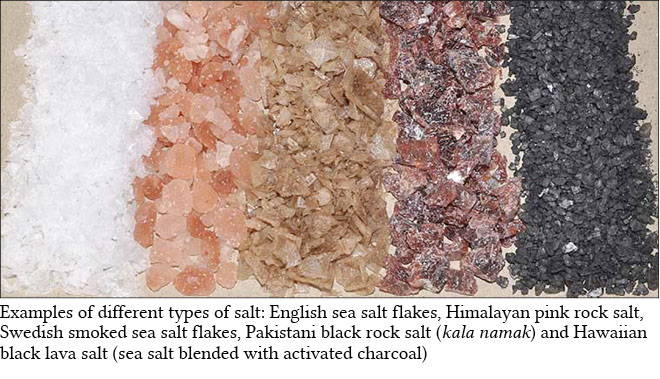
Saltiness
Salt or table salt is a crystalline mineral composed mainly of sodium chloride (NaCl). It is one of the oldest food seasonings. The word “salary” comes from the Latin word salarium, the money given to a Roman soldier to buy salt. Salzburg and Hallstatt in Austria are traditional centres of salt production (named after the German and Celtic words for salt – Zalze and Hall). Salt is provided in salt shakers or salt mills on most dinner tables around the world. Salt may be unrefined (e.g. sea salt) and therefore add some aroma compounds when sprinkled on food. Refined salt (e.g. table salt) may be 100% pure but sometimes contains small amounts of additives such as iodine, fluoride, iron or folic acid to counteract the symptoms of mineral deficiencies. Seasoned salts contain herbs, spices and flavour enhancers. In Chinese and other East Asian cuisines, salty soy sauce, fish sauce or oyster sauce are traditionally used for seasoning (while cooking) and not salt. Salt is essential to regulate the fluid balance of the body but excessive intake may increase the risk of high blood pressure. The recommended daily intake of salt in healthy adults is 4 000 mg (ca. 0.14 oz) per day (UK) and the upper limit is set at 5 750 mg (ca. 0.2 oz) in the USA, Canada, Australia and New Zealand. When a comparative measure of the saltiness of food is required, then sodium chloride is used as reference, with an arbitrary saltiness value of 1.
Salting is a method to preserve food using dry edible salt, similar to pickling with brine (salty water). Most microorganisms that cause food decay are unable to survive in high salt environments because of the high osmotic pressure. The brine often contains nitrites (saltpetre) because it gives otherwise grey-coloured pickled meat products such as salami and corned beef an attractive reddish colour. Potassium nitrate (KNO3) is not only the original ingredient for making gunpowder and fertilizer but also one of several nitrogen-containing compounds referred to as saltpetre. Sodium nitrate (NaNO3) and especially the more effective sodium nitrite (NaNO2) are nowadays preferred for pickling and as a food ingredient to ensure food safety.
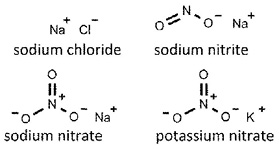
Bitterness
The ability of humans to detect bitter-tasting, toxic substances at very low levels must have been an important survival mechanism for our species. Bitterness is the most sensitive of the tastes and is usually regarded as unpleasant but many foods and drinks are inherently bitter or are intentionally spiked with bittering agents such as hops or various alcoholic preparations known as bitters. Examples include ale, beer, bitter gourd, chicory leaves, cocoa, coffee, citrus peel, dandelion leaves, marmalade, maté, olives and tonic water. Quinine is the bitter-tasting alkaloid in tonic water where it is added at a level of about 2.7 g per litre. This alkaloid is used as a reference standard to compare the bitterness of substances and has been assigned a bitterness value of 1. It has a detection limit of 0.0026 g per litre. The most bitter of all known substances is denatonium, which has a bitterness value of 1 000. Denatonium benzoate is added to industrial liquids as a bitterant and aversive agent to prevent people (especially children) from accidentally ingesting toxic liquids such as methanol and antifreeze (ethylene glycol). The ability to taste bitterness varies from person to person. Two synthetic substances (phenylthiocarbamide and 6-n-propylthiouracil) are tasteless to some persons but bitter to others and are commonly used to study the genetics of bitter perception.
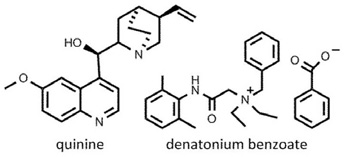
In recent years there has been a revival of the concept of the amarum (bitter-tasting substances) or aromaticum amarum (aromatic bitters, such as “Angostura” tonic) that enhances appetite and good digestion. Bitter compounds not only stimulate the flow of saliva but the bitter taste in the mouth sends a signal (via the nervous vagus) to the stomach to increase the excretion of gastric juices. The ancient practice of eating bitter herbs or drinking bitter tonics has continued to this day and the customary gin and tonic before dinner makes perfect sense from a digestive point of view. The art of balancing the bitterness of food items such as olives and chicory leaves with salty, sweet, sour or umami tastes is at the heart of many culinary customs and traditional recipes.

Umami
Umami is a savoury or “meaty” taste caused by amino acids, which results in a mouth-watering effect and a long-lasting aftertaste that balances and integrates all the flavours of a dish. It is one of the five basic tastes which also include sweet, sour, salty and bitter. Umami was first discovered by the Japanese scientist Kikunae Ikeda in 1908, who created the term from the Japanese words umai (“delicious”) and mi (“taste”).

The taste is caused by L-glutamate, an abundant naturally occurring non-essential amino acid, and also by 5’-ribonucleotides such as guanosine-5’-monophosphate (GMP) and inosine-5’-monophosphate (IMP).
Umami was scientifically recognized as a fifth taste, distinct from saltiness, as recently as 1985. The ability to detect the umami taste is due to the presence of specialized receptors on human and animal tongues. Glutamate in its acid form has almost no effect, but the salts of glutamic acid, known as glutamates, ionize to give the distinctive taste of umami, detected on the tongue as the carboxylate anion of glutamate. For this reason the sodium salt of glutamate (monosodium glutamate or MSG) is used in commercial flavour enhancers. The overall taste-enhancing effect is strengthened by the simultaneous use of GMP and IMP which act with MSG in a synergistic way – the taste intensity is increased beyond that of the sum of the two ingredients.
Yeast extracts or yeast spreads are the common names for different types of yeast products used as flavour enhancers and food additives. They are made by natural enzymatic processes (autolysed yeast) or by acid hydrolysis (hydrolysed yeast), during which the proteins of yeast cells (mostly brewer’s yeast, Saccharomyces cerevisiae) are broken down to amino acids and peptides, in much the same way as soy sauce and soy pastes are made. The products are in the form of liquids, pastes and powders and contain guanosine monophosphate (GMP) as a major umami flavour compound. Yeast autolysates are well known by their brand names in various countries, including Marmite and Oxo (UK, Ireland, South Africa and New Zealand), Vegemite (Australia), Cenovis (Switzerland) and Vitam-R (Germany). These products are almost unknown in the USA and other countries.
There is some controversy around the use of MSG and the addition of yeast extracts as natural flavourants. Some people are sensitive to MSG and numerous anecdotes of headaches and other side effects have been reported since 1968 by people who have eaten a Chinese meal, so that the syndrome became known as the Chinese Restaurant Syndrome. There is as yet no convincing scientific evidence that the levels normally used in food or naturally present in food are harmful except when large amounts are taken without food. It is interesting to observe the link between MSG and GABA (gamma-aminobutyric acid), a well-known inhibitory neurotransmitter that can be formed from MSG by a single decarboxylation step. The mind- and mood-enhancing effects of substances such as capsaicin (see chilli), myristicin (see nutmeg) and MSG, and their role in the pleasure of the dining experience remain as a fascinating topic for future research.
The umami taste has been used since ancient times because it occurs naturally in many different food items. A fermented fish sauce known as garum was popular in Roman times. This traditional source of glutamate is also employed in Chinese and other Asian cuisines where soy sauce, fish sauce, shrimp paste and other fermentation products are essential ingredients. In Western countries, ripe tomatoes, cheese, mushrooms and cured meats, all rich in glutamates and inosinates, serve the same purpose. Recent inventions of black sauces and pastes (e.g. Worcestershire sauce, Maggi sauce, Marmite and Vegemite) were inspired by the ancient custom of fermenting fish and soy proteins. The process is nowadays accomplished in three days by acid hydrolysis (using hydrochloric acid) of vegetable proteins (often wheat protein) to produce hydrolysed vegetable protein (HVP), rich in glutamates. The synergistic effects brought about by the umami taste explain why certain food combinations have become classics. Umami was first discovered in the basic Japanese broth known as dashi, in which there is a synergistic interaction between the glutamate in fermented kombu seaweed and the ribonucleotides in dried bonito (fish) flakes. Similar food parings of other culinary traditions come to mind, where vegetables and cheese, both rich in glutamates are combined with beef, pork, chicken or fish, all rich in inosinates. Examples are Parmesan cheese with tomato and mushrooms in Italian pastas and pizzas, leeks and chicken meat in Chinese chicken soup and Scottish cock-a-leekie, and cheese and beef in an American cheeseburger. An excellent dish also requires the correct choice and amount of herbs and spices that will create balance, add complexity or round out the overall flavour even more.